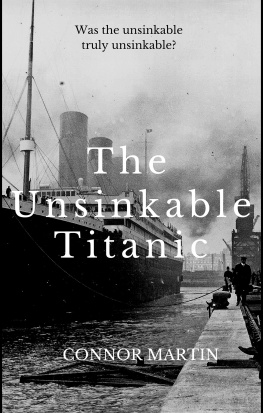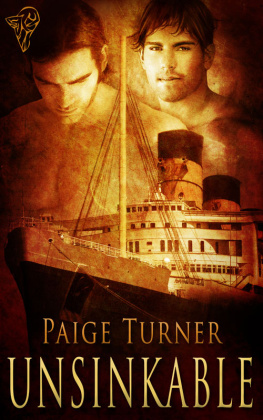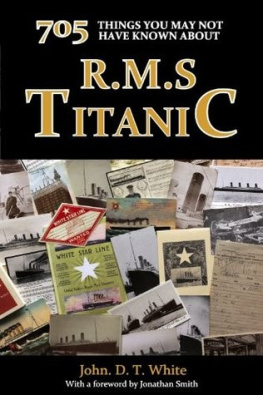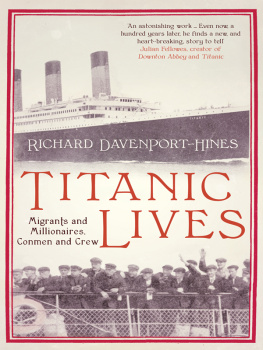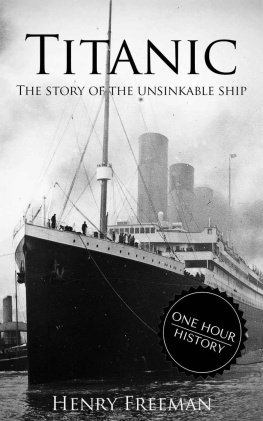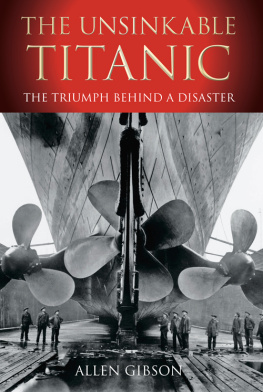Martin - The unsinkable titanic
Here you can read online Martin - The unsinkable titanic full text of the book (entire story) in english for free. Download pdf and epub, get meaning, cover and reviews about this ebook. year: 2016, genre: Science fiction. Description of the work, (preface) as well as reviews are available. Best literature library LitArk.com created for fans of good reading and offers a wide selection of genres:
Romance novel
Science fiction
Adventure
Detective
Science
History
Home and family
Prose
Art
Politics
Computer
Non-fiction
Religion
Business
Children
Humor
Choose a favorite category and find really read worthwhile books. Enjoy immersion in the world of imagination, feel the emotions of the characters or learn something new for yourself, make an fascinating discovery.
- Book:The unsinkable titanic
- Author:
- Genre:
- Year:2016
- Rating:3 / 5
- Favourites:Add to favourites
- Your mark:
- 60
- 1
- 2
- 3
- 4
- 5
The unsinkable titanic: summary, description and annotation
We offer to read an annotation, description, summary or preface (depends on what the author of the book "The unsinkable titanic" wrote himself). If you haven't found the necessary information about the book — write in the comments, we will try to find it.
The unsinkable titanic — read online for free the complete book (whole text) full work
Below is the text of the book, divided by pages. System saving the place of the last page read, allows you to conveniently read the book "The unsinkable titanic" online for free, without having to search again every time where you left off. Put a bookmark, and you can go to the page where you finished reading at any time.
Font size:
Interval:
Bookmark:
UNSINKABLE
TITANIC
BY
CONNOR MARTIN
HistoryClio
To
THE MEMORY OF THE CHIEF ENGINEER OF THE TITANIC,
JOHN BELL,
AND HIS STAFF OF THIRTY-THREE ASSISTANTS,
WHO STOOD AT THEIR POSTS IN THE ENGINE-
AND BOILER-ROOMS TO THE VERY LAST,
AND WENT DOWN WITH THE SHIP,
THIS WORK IS DEDICATED
It is the object of this work to show that, in our eagerness to make the ocean liner fast and luxurious, we have forgotten to make her safe.
The safest ocean liner was the Great Eastern; and she was built over a hundred and fifty years ago. Her designer aimed to make the ship practically unsinkableand he succeeded; for she passed through a more severe ordeal than the Titanic, survived it, and came into port under her own steam.
Since her day, the shipbuilder has eliminated all but one of the safety devices which made the Great Eastern a ship so difficult to sink. Nobody, not even the shipbuilders themselves, seemed to realise what was being done, until, suddenly, the worlds finest vessel, in all the pride of her maiden voyage, struck an iceberg and went to the bottom in something over two and a half hours time!
If we learn the lesson of this tragedy, we shall lose no time in getting back to first principles. We shall reintroduce in all future passenger ships those simple and effective elements of safetythe double skin, the longitudinal bulkhead, and the watertight deckwhich were conspicuous in the Great Eastern, and which alone can render such a ship as the Titanic unsinkable.
| CHAPTER | PAGE |
| I. | Introductory |
| II. | The Ever-Present Dangers of the Sea |
| III. | Every Ship Its Own Lifeboat |
| IV. | Safety Lies in Subdivision |
| V. | The Unsinkable Great Eastern of 1858 |
| VI. | The Sinkable Titanic |
| VII. | How the Great Ship Went Down |
| VIII. | Warship Protection Against Ram, Mine, and Torpedo |
| IX. | Warship Protection as Applied to Some Ocean Liners |
| X. | Conclusions |
INTRODUCTORY
Among the many questions which have arisen out of the loss of the Titanic there is one, which, in its importance as affecting the safety of ocean travel, stands out preminent:
Why did this ship, the latest, the largest, and supposedly the safest of ocean liners, go to the bottom so soon after collision with an iceberg?
The question is one to which, as yet, no answer that is perfectly clear to the lay mind has been made. We know that the collision was the result of daring navigation; that the wholesale loss of life was due to the lack of lifeboats and the failure to fill completely the few that were available; and that, had it not been for the amazing indifference or stupidity of the captain of a nearby steamer, who failed to answer the distress signals of the sinking vessel, the whole of the ships complement might have been saved.
But the ship itselfwhy did she so quickly go to the bottom after meeting with an accident, which, in spite of its stupendous results, must be reckoned as merely one among the many risks of transatlantic travel?
So far as the loss of the ship itself was concerned, it is certain that the stupefaction with which the news of her sinking was received was due to the belief that her vast size was a guarantee against disasterthat the ever-increasing dimensions of length, breadth, and tonnage had conferred upon the modern ocean liner a certain immunity against the dangers of travel by sea. The fetish of mere size seems, indeed, to have affected even the officers in command of these modern leviathans. Surely it must have thrown its spell over the captain of the ill-fated Titanic, who, in spite of an oft-repeated warning that there was a large field of ice ahead, followed the usual practice, if the night is clear, and ran his ship at full speed into the zone of danger, as though, forsooth, he expected the Titanic to brush the ice floes aside, and split asunder any iceberg that might stand in her way.
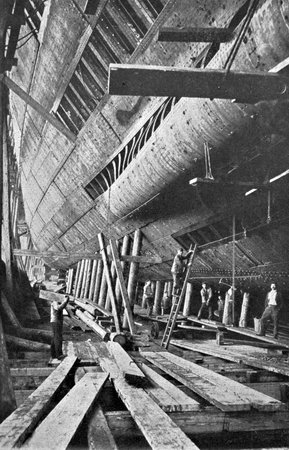
Courtesy of Scientific American
Rivetting the Outer Skin on the Frames of a 65,000-Ton Ocean Liner
Confidence in the indestructibility of the Titanic, moreover, was stimulated by the fact that she was supposed to be the last word in first-class steamship construction, the culmination of three-quarters of a century of experience in building safe and stanch vessels. In the official descriptions of the ship, widely distributed at the time of her launching, the safety elements of her construction were freely dwelt upon. This literature rang the changes on stout bulkheads, watertight compartments, automatic, self-closing bulkhead doors, etc.,and honestly so. There is every reason to believe that the celebrated firm who built the ship, renowned the world over for the high character of their work; the powerful company whose flag she carried; aye, and even her talented designer, who was the first to pronounce the Titanic a doomed vessel and went down with the ship, were united in the belief that the size of the Titanic and her construction were such that she was unsinkable by any of the ordinary accidents to which the transatlantic liner is liable.
How comes it, then, that this noble vessel lies to-day at the bottom of the Atlantic in two thousand fathoms of water?
A review of the progress of those constructive arts which affect the safety of human life seems to show that it needs the spur of great disasters, such as this, to concentrate the attention of the engineer and the architect upon the all-important question of safety. More important than considerations of convenience, economy, speed of construction, or even revenue-earning capacity, are those of the value and sanctity of human life. Too frequently these considerations are the last to receive attention. This is due less to indifference than to inadvertencea failure to remember that an accident which may be insignificant in its effect on steel and stone, may be fatal to frail flesh and blood. Furthermore, the monumental disasters, and particularly those occurring in this age of great constructive works, are frequently traceable to hidden or unsuspected causes, the existence and potentialities of which are revealed only when the mischief has been done. A faulty method of construction, containing in itself huge possibilities of disaster, may be persisted in for years without revealing its lurking menace. Here and there, now and then, some minor mischance will direct the attention of the few to the peril; but the excitement will be local and passing. It takes a horrora holocaust of human life, with all its attendant exploitation in the press and the monthly magazine, to awaken a busy and preoccupied world to the danger and beget those stringent laws and improved constructions which are the earmarks of progress towards an ideal civilisation.
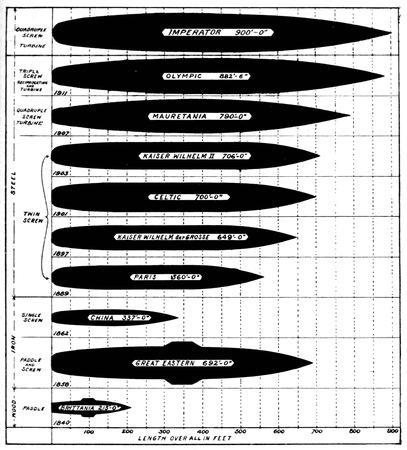
Courtesy of Scientific American.
Note how far the Great Eastern was ahead of her time. She was not exceeded until the advent of the Oceanic in 1899.
Growth of the Transatlantic Steamer from 1840 to 1912
Font size:
Interval:
Bookmark:
Similar books «The unsinkable titanic»
Look at similar books to The unsinkable titanic. We have selected literature similar in name and meaning in the hope of providing readers with more options to find new, interesting, not yet read works.
Discussion, reviews of the book The unsinkable titanic and just readers' own opinions. Leave your comments, write what you think about the work, its meaning or the main characters. Specify what exactly you liked and what you didn't like, and why you think so.

